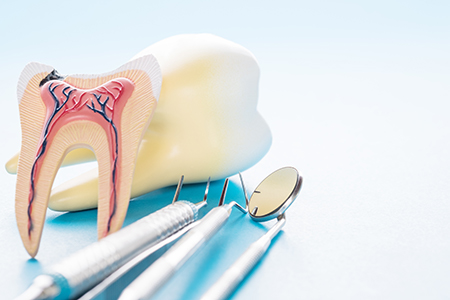We speak English, Spanish and Portuguese
We speak English, Spanish and Portuguese

Being told you need a root canal can feel intimidating, but modern endodontic care is designed to relieve pain and preserve your tooth with minimal discomfort. Advances in techniques, instruments, and anesthesia mean that most root canal procedures are comparable to routine restorative work in terms of patient comfort. The goal is straightforward: remove the source of infection or inflammation, protect the remaining tooth structure, and restore a healthy, functional smile.
Our team uses precise diagnostics and careful treatment planning to deliver efficient, evidence-based care. At Inspirational Smiles, patient comfort and clear communication are central to every visit — we explain each step so you know what to expect and why a particular approach is recommended.
When possible, saving a natural tooth is usually the healthiest long-term option. A tooth that has been preserved with root canal therapy continues to perform its role in chewing, speaking, and supporting surrounding teeth and bone. Removing a tooth instead of treating its infected internal tissue often leads to additional restorative work later on, such as crowns, bridges, or implants, which can be more involved than root canal therapy paired with a protective restoration.
Root canal treatment has a strong track record of success when performed with modern protocols. By removing damaged nerve tissue and sealing the internal canal system, the procedure eliminates infection and creates an environment where surrounding tissues can heal. With the correct follow-up restoration and routine home care, treated teeth can last many years — frequently for the lifetime of the patient.
Choosing root canal therapy is a decision based on preserving overall oral health and function. When a tooth is retained, it helps maintain proper alignment and chewing efficiency, which supports overall oral stability. Discussing the long-term outlook with your dentist helps ensure you make an informed choice that aligns with your oral health goals.

Inside each tooth is a soft core made up of connective tissue, nerves, and blood vessels known collectively as the dental pulp. This tissue supports development of the tooth and provides sensory feedback while the tooth is alive. When decay progresses deep into the tooth, or when a tooth suffers a fracture or traumatic injury, bacteria can reach the pulp and trigger inflammation or infection.
In many cases, the first clues that the pulp has been affected are changes in sensation. You might notice heightened sensitivity to hot or cold that lingers, a sharp pain when biting, or a dull ache that persists. Sometimes the affected tooth darkens in color, or nearby gum tissues may become swollen. Other times, radiographic imaging taken during a routine exam reveals problems before symptoms appear.
Not every ache requires root canal therapy, but certain warning signs should prompt evaluation by a dental professional. Early diagnosis and appropriate treatment reduce the chance of the infection spreading and limit the complexity of care needed to restore the tooth.
Some common indicators that root canal therapy may be needed include:
Pain that continues despite home remedies, or discomfort that wakens you from sleep, often suggests an advancing problem within the tooth. This kind of persistent pain is a signal that the pulp may be compromised and should be evaluated.
Brief sensitivity to hot or cold is common, but when sensations linger long after the stimulus is removed, the underlying pulp may be inflamed or dying. Noting when and how the sensitivity occurs helps your dentist diagnose the issue.
Discomfort when chewing or when the tooth is lightly tapped can indicate inflammation or infection in the tissues beneath the crown. This symptom often points to nerve involvement or a developing abscess.
A tooth that becomes darker than neighboring teeth may have undergone internal changes due to trauma or longstanding infection. This discoloration can be an important diagnostic clue.
Even a small crack can provide a pathway for bacteria to reach the pulp, and traumatic injuries may disrupt blood flow to internal tissues. Both scenarios can lead to pulp damage requiring treatment.
Swollen gums, a tender bump on the gum tissue, or discharge are signs of infection in the area. These symptoms merit timely assessment to prevent more significant complications.
As infection advances, it can affect the bone and fibers that anchor the tooth, sometimes causing mobility. Treating the source of infection can often stop further damage and allow healing.

Early intervention is often the difference between straightforward care and a more complicated course of treatment. When a tooth is assessed promptly, the infection is typically more localized and easier to manage. Delaying care can allow bacteria to spread, inflame surrounding tissues, and make subsequent procedures more extensive.
Sometimes a problem is discovered before it causes pain, during routine radiographs or exams. These findings can include signs of root-end changes, bone loss around the root tip, or internal resorption. Detecting these early preserves options for conservative treatment and reduces the risk of systemic impact from an untreated oral infection.
Prompt treatment also helps protect adjacent teeth and supporting bone. Addressing the source of infection and restoring the treated tooth with a durable crown or restoration restores function and reduces the likelihood of repeat procedures in the future.
Modern root canal therapy follows a clear, methodical process designed to remove infection, disinfect the root canal system, and seal the tooth. After a thorough exam and appropriate imaging, we begin by numbing the area and isolating the tooth to keep it clean and dry during the procedure. A small opening is made in the crown so the interior can be accessed.
Specialized instruments are used to remove inflamed or infected pulp tissue and to shape the canal system so it can be thoroughly cleaned. Irrigating solutions help flush debris and reduce bacterial load. Once the canals are disinfected, they are filled with a biocompatible material that seals the space and prevents reinfection.
Some cases are completed in a single visit; others require multiple appointments, particularly when infection control or complex anatomy demands staged care. Throughout, your dentist will discuss anesthesia options and, if helpful, available approaches to reduce anxiety so the experience is as comfortable as possible.

After the procedure, it’s common to experience some tenderness for a few days while surrounding tissues settle. Over-the-counter pain relievers are often sufficient to manage this discomfort; your dentist will provide guidance on what to expect and when to seek follow-up care. If antibiotics are prescribed for an active infection, it’s important to take them as directed.
A temporary filling may be placed until a permanent restoration is fabricated. Because a tooth that has undergone root canal therapy can be more prone to fracture, placing a crown or an appropriate final restoration restores strength and function. Scheduling this final restoration in a timely way helps protect the treated tooth for the long term.
Good daily oral hygiene and regular dental checkups help ensure the tooth remains healthy after treatment. With proper restoration and ongoing care, a treated tooth can function comfortably for many years. If new or persistent symptoms arise at any point, contacting your dental provider promptly allows for early evaluation and management.
With thoughtful treatment and routine maintenance, root canal therapy preserves your natural dentition and helps maintain oral health and comfort. If you have questions about whether root canal treatment is the right option for your situation, our team is here to provide clear, evidence-based guidance.
For more information or to schedule an evaluation, please contact us — our staff is ready to help you understand your options and plan the care that best meets your needs.

A root canal procedure is the best way to save a tooth that has been damaged by decay or injury and preserve your natural smile. The alternative is an extraction and treatment to replace the tooth. While at times a tooth is non-restorable and an extraction is the only option, when possible, it’s best to try and save your natural tooth. With proper care, a tooth with root canal therapy can serve your smile well for many years to come.
Despite lingering myths from before the age of modern dental anesthesia and technology, having a root canal procedure today is as routine and comfortable as visiting the dentist for a filling. While the procedure is performed under local anesthesia with your tooth completely numbed, we can also discuss options in dental sedation.
Whether the symptoms of a dental infection subside after a course of antibiotics, a draining abscess provides you with some temporary pain relief, or a tooth with radiographic evidence of pathology has not yet developed symptoms, it’s essential, before an infection worsens or occurs, to have a root canal procedure performed. In this way, the tooth can be disinfected, filled, and sealed to protect your health and avoid further problems.
If you have sustained a dental injury, have a toothache, jaw pain, swelling, or are experiencing any other unusual and uncomfortable oral symptoms, contact our office immediately for care. Dental problems that have not been evaluated and treated can significantly worsen, producing more severe damage and consequences for the involved teeth, your oral health, and even your overall wellbeing. Once you get in touch with our office, our friendly and compassionate office team will get you in for care at your earliest convenience.
While some root canal procedures can be completed in one visit, others may involve 2 or 3 appointments. How long it takes depends on various factors, including active infection, the number of canals in the tooth, and the tooth’s location or anatomy.
With a success rate that exceeds 95%, root canal therapy remains the most effective procedure to save a tooth in which the inner vital tissues have been damaged. However, as with all healthcare procedures, there are a small percentage of cases where the teeth become symptomatic a second time. The good news is that many of these teeth can still be saved with root canal retreatment or a minor surgical procedure known as an apicoectomy.
The best ways to maintain a tooth with root canal therapy are to get the proper restoration required to rebuild and protect the tooth, maintain proper oral hygiene, and schedule appointments for routine dental checkups and care.
Saving a tooth with root canal therapy is a wise investment that, in the long run, is typically less costly and invasive than having the tooth extracted and replaced with a fixed bridge or implant. As far as the exact cost of care, it can vary depending on which tooth is being treated. Many dental insurance plans provide coverage for root canal therapy. At the office of Inspirational Smiles, we do our best to optimize your dental benefits and minimize your out-of-pocket expenses. Our staff will answer all your questions about the cost of care and discuss all your payment options.
At the office of Inspirational Smiles, we use the latest technology and most effective methods of care to provide precise and gentle care. Our reputation for excellence is based upon a consistent record of achieving successful treatment outcomes while providing prompt, stress-free, and convenient treatment for every type of dental need.
A root canal is a dental procedure that removes infected or inflamed pulp from inside a tooth and then seals the internal canal system to prevent reinfection. The treatment preserves the natural tooth so it can continue to function for biting, chewing, and supporting adjacent teeth. Dentists recommend root canal therapy when decay, fracture, or trauma has allowed bacteria to reach the pulp and cause persistent inflammation or infection.
By eliminating the source of infection and disinfecting the canals, root canal therapy helps surrounding tissues heal and reduces the risk of the infection spreading. Modern techniques and materials improve predictability and stability of the treated tooth. Preserving the natural tooth often reduces the need for more complex restorative work later and supports overall oral health.
A tooth becomes infected when bacteria penetrate the enamel and dentin and reach the dental pulp, or when trauma disrupts the tooth's blood supply and allows bacteria to colonize internal tissues. Common pathways include deep decay, cracks or fractures, and injuries that expose the inner tooth to bacteria. Early stages of pulp involvement may be asymptomatic, which is why routine exams and radiographs are important for detection.
Symptoms that should prompt a dental evaluation include lingering sensitivity to hot or cold, persistent or throbbing pain, pain on biting, darkening of the tooth, swelling of the gums, or a tender bump near the tooth. Not every ache requires root canal therapy, but these signs warrant timely assessment to limit the extent of treatment needed. Early diagnosis improves the chance for conservative, successful care.
Modern root canal therapy follows a systematic process designed to remove infected tissue, disinfect the canal system, and seal the space to prevent reinfection. After a thorough exam and appropriate imaging, the area is anesthetized and the tooth is isolated to keep the field clean and dry. A small access opening is made through the crown so instruments and irrigants can reach and shape the canals before they are filled with a biocompatible material.
Some cases are completed in a single appointment, while others require multiple visits when infection control or complex anatomy demands staged care. Throughout the procedure your dentist will discuss anesthesia options and steps taken to maintain comfort. The final phase typically involves placing a temporary filling and planning for a durable restoration to protect the treated tooth.
Thanks to local anesthesia and contemporary techniques, most patients experience little to no pain during the actual root canal procedure. Discomfort afterward is usually mild and short lived, often manageable with over-the-counter analgesics and supportive care as directed by the dentist. Your provider will explain expected sensations and offer guidance to reduce anxiety and improve comfort during treatment.
If intense or worsening pain, fever, or spreading swelling occurs after treatment, contacting your dental office is important so the area can be reassessed and managed promptly. Antibiotics may be prescribed only when clinically indicated for an active spreading infection. Follow-up visits ensure healing is progressing and allow the clinician to address any concerns early.
The primary alternative to root canal therapy is extraction of the affected tooth, followed by replacement options such as a dental implant, bridge, or removable prosthesis. Extraction eliminates the infected tooth but also removes the natural root, which can affect chewing efficiency, nearby tooth alignment, and bone preservation over time. For many patients, preserving the natural tooth with a root canal and appropriate restoration is the more conservative approach when feasible.
Choosing between treatment options depends on factors such as the tooth's restorability, the extent of infection or damage, overall oral health, and the patient's long-term goals. Your dentist will review the benefits and limitations of each choice, helping you make an informed decision aligned with your oral health needs. In some cases a referral to a specialist may be recommended for complex anatomy or retreatment scenarios.
Preparing for a root canal typically involves maintaining your regular oral hygiene, bringing a list of current medications and health conditions, and arriving well nourished unless instructed otherwise. If you experience dental anxiety, discuss sedation or calming techniques with the team so appropriate measures can be arranged to help you relax. Radiographs and a thorough exam prior to treatment allow the clinician to develop an efficient, evidence-based plan.
At Inspirational Smiles we prioritize clear communication, so come prepared with questions about anesthesia, expected recovery, and follow-up restoration. If you have a medical condition or take medications that affect bleeding or immunity, inform the office ahead of time so any necessary coordination with your medical providers can occur. Planning ahead helps the appointment proceed smoothly and safely.
After a root canal it is common to experience mild tenderness for several days while surrounding tissues settle; this discomfort usually lessens each day. Over-the-counter pain relievers are often sufficient, and your dentist will provide specific guidance about medications, activity, and eating. Avoid chewing on the treated tooth until a permanent restoration is placed to reduce the risk of fracture.
If antibiotics are prescribed for an active infection, take the complete course as directed and follow up if symptoms persist or worsen. Keep up with home care, including gentle brushing and flossing, and attend scheduled follow-up appointments to verify healing. If you notice increasing pain, swelling, or a return of symptoms after initial improvement, contact the practice promptly for reevaluation.
A tooth that has undergone root canal therapy can become more brittle because the pulp tissue that once provided internal moisture and resilience is removed; a crown restores strength and protects the tooth from fracture. Crowns also provide a durable, sealed surface that shields the restored canal system and reduces the chance of leakage or reinfection. The type of final restoration is chosen based on the tooth's location, remaining tooth structure, and functional demands.
Scheduling the permanent restoration in a timely manner helps maximize the long-term success of the treated tooth. Your dentist will evaluate the tooth and discuss crown materials and timelines to achieve both functional and esthetic goals. Proper restoration combined with routine dental care helps ensure the treated tooth remains serviceable for many years.
With appropriate treatment, a well-restored tooth that has received root canal therapy can last many years and often for the lifetime of the patient. Longevity depends on factors such as the quality of the initial treatment, the type and timing of the final restoration, oral hygiene, and habits like grinding or biting hard objects. Regular dental checkups and radiographs help monitor the treated tooth and address issues before they compromise long-term success.
To protect a root canal-treated tooth, maintain consistent brushing and flossing, wear a night guard if you grind your teeth, and avoid using the tooth to open or bite hard items. Report new or recurring symptoms such as swelling, pain, or changes in bite to your dentist promptly. Early intervention preserves options and often simplifies corrective care when needed.
Seek prompt dental care if you experience severe, unrelenting tooth pain, rapidly spreading swelling of the face or gums, fever with oral symptoms, or significant trauma that dislodges or fractures a tooth. These signs can indicate an active or advancing infection that requires urgent evaluation to prevent more serious complications. Timely assessment often allows for conservative interventions that limit the extent of treatment required.
If you are experiencing an urgent dental issue outside regular hours, contact your dental office as instructed for guidance on next steps and possible emergency arrangements. For patients in Cumming, GA, your local dental team can advise whether immediate in-office care, a temporary measure, or referral is appropriate. Quick action protects your oral health and helps ensure the best possible outcome.

Looking to schedule your next dental visit or learn more about our services?
Getting in touch with Inspirational Smiles is simple! Our caring team is ready to help with appointment scheduling, questions about treatments, or any concerns you may have. You can call us or use our easy online contact form—whatever works best for you.
Take the first step toward a healthier, more confident smile today and experience the difference that personalized, compassionate dental care can make.